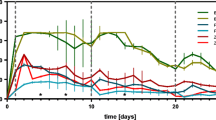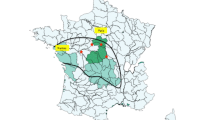Abstract
Liver concentrations of polychlorinated biphenyls (PCBs) and chicken embryo hepatocyte (CEH) bioassay-derived 2,3,7,8-tetrachlorodibenzo-p-dioxin equivalents (TCDD-EQs) were measured in livers of adult herring gulls (Larus argentatus) collected from several locations on the Great Lakes and two reference sites. Total PCB concentrations (sum of 42 congeners) and TCDD-EQ concentrations were compared with hepatic ethoxyresorufin-O-deethylase (EROD) activity, methoxyresorufin-O-deethylase (MROD) activity and immunodetectable cytochrome P4501A (CYP1A) protein concentration. EROD and MROD activity were not significantly correlated with total PCB concentration or TCDD-EQ concentration in liver tissue. CYP1A protein concentration was significantly correlated with total PCB concentration, but the linear relationship had little predictive power. We conclude that EROD is not a useful biomarker of PCB exposure in the adult herring gull.
Similar content being viewed by others
References
Bello, S.M., Franks, D.G., Stegeman, J.J. and Hahn, M.E. (2001). Acquired resistance to Ah receptor agonists in a population of Atlantic killifish (Fundulus heteroclitus) inhabiting a marine superfund site: in vivo and in vitro studies on the inducibility of xenobiotic metabolizing enzymes. Toxicol. Sci. 60, 77-91.
Boersma, D.C., Ellenton, J.A. and Yagminas, A. (1986). Investigation of the hepatic mixed-function oxidase system in herring gull embryos in relation to environmental contaminants. Environ. Toxicol. Chem. 5, 309-18.
Bosveld, A.T.C. (1995). Effects of polyhalogenated aromatic hydrocarbons on piscivorous avian wildlife. Ph.D. Dissertation, University of Utrecht, 1-171.
Bosveld, A.T.C., Gradener, J., Murk, A.J., Brouwer, A., van Kampen, M., Evers, E.H.G. and van den Berg, M. (1995). Effects of PCDDs, PCDFs and PCBs in common tern (Sterna hirundo) breeding in estuarine and coastal colonies in the Netherlands and Belgium. Environ. Toxicol. Chem. 14, 99-115.
Brouwer, A., Murk, A.J. and Koeman, J.H. (1990). Biochemical and physiological approaches in ecotoxicology. Funct. Ecol. 4, 275-81.
Brunström, B. (1988). Sensitivity of embryos from duck, goose, herring gull, and various chicken breeds to 3,3′,4,4′-tetrachlorobiphenyl. Poult. Sci. 67, 52-7.
Brunström, B. and Reutergårdh, L. (1986). Differences in sensitivity of some avian species to the embryotoxicity of a PCB, 3,3′4,4′-tetrachlorobiphenyl, injected into the eggs. Environ. Pollut. 42, 37-45.
Custer, C.M., Custer, T.W., Allen, P.D., Stromborg, K.L. and Melancon, M.J. (1998). Reproduction and environmental contamination in tree swallows nesting in the Fox River drainage and Green Bay, Wisconsin, USA. Environ. Toxicol. Chem. 17, 1786-98.
Davis, J.A., Fry, D.M. and Wilson, B.W. (1997). Hepatic ethoxyresorufin-O-deethylase activity and inducibility in wild populations of double-crested cormorants (Phalacrocorax auritus). Environ. Toxicol. Chem. 16, 1441-9.
Ellenton, J.A., Brownlee, L.J. and Hollebone, B.R. (1985). Aryl hydrocarbon hydroxylase levels in herring gull embryos from different locations on the Great Lakes. Environ. Toxicol. Chem. 4, 615-22.
Feeley, M. and Brouwer, A. (2000). Health risks to infants from exposure to PCBs, PCDDs and PCDFs. Food Addit. Contam. 17, 325-33.
Fossi, C., Leonzio, C. and Focardi, S. (1986). Mixed function oxidase activity and cytochrome P-450 forms in black-headed gulls feeding in different areas. Mar. Poll. Bull. 17, 546-8.
Fox, G.A., Grasman, K.A., Hobson, K.A., Williams, K., Jeffery, D. and Hanbridge, B. (2002). Contaminant residues in tissues of adult and prefledged herring gulls from the Great Lakes in relation to diet in the early 1990s. J. Great Lakes Res. 28, 643-63.
Gilday, D., Gannon, M., Yutzey, K., Balder, D. and Rifkind, A.B. (1996). Molecular cloning and expression of two novel avian cytochrome P450 1A enzymes induced by 2.3,7.8-tetrachlorodibenzo-p-dioxin. J. Biol. Chem. 271, 33054-9.
Grasman, K.A., Fox, G.A., Scanlon, P.F. and Ludwig, J.P. (1996). Organochlorine-associated immunosuppression in prefledgling Caspian terns and herring gulls from the Great Lakes: an ecoepidemiological study. Environ. Health Perspect. 104(Suppl. 4), 829-42.
Hahn, M.E. (1998). Mechanisms of innate and acquired resistance to dioxin-like compounds. Rev. Toxicol. 2, 395-443.
Hahn, M.E., Woodward, B.L., Stegeman, J.J. and Kennedy, S.W. (1996). Rapid assessment of induced cytochrome P4501A protein and catalytic activity in fish hepatoma cells grown in multiwell plates: response to TCDD, TCDF, and two planar PCBs. Environ. Toxicol. Chem. 15, 582-91.
Hebert, C.E., Norstrom, R.J. and Weseloh, D.V.C. (1999). A quarter century of environmental surveillance: The Canadian Wildlife Services's Great Lakes herring gull monitoring program. Environ. Rev. 7, 147-66.
Henriksen, E.O., Gabrielsen, G.W., Skaare, J.U., Skegstad, N. and Jenssen, B.M. (1998). Relationships between PCB levels, hepatic EROD activity and plasma retinol in glaucous gulls, Larus hyperboreus. Mar. Environ. Res. 46, 45-9.
Henriksen, E.O., Gabrielsen, G.W., Trudeau, S., Wolkers, J., Sagerup, K. and Skaare, J.U. (2000). Organochlorines and possible biochemical effects in glaucous gulls (Larus hyperboreus) from Bjornoya, the Barents Sea. Arch. Environ. Contam. Toxicol. 38, 234-43.
Hoffman, D.J., Smith, G.J. and Rattner, B.A. (1993). Biomarkers of contaminant exposure in common terns and black-crowned night herons in the Great Lakes. Environ. Toxicol. Chem. 12, 1095-103.
Karchner, S.I., Kennedy, S.W., Trudeau, S. and Hahn, M.E. (2000). Towards a molecular understanding of species differences in dioxin sensitivity: initial characterization of Ah receptor cDNAs in birds and an amphibian. Mar. Environ. Res. 50, 51-6.
Kennedy, S.W., Fox, G.A., Trudeau, S., Bastien, L.J. and Jones, S.P. (1998). Highly carboxylated porphyrin concentration: a biochemical marker of PCB exposure in herring gulls. Mar. Environ. Res. 46, 65-9.
Kennedy, S.W. and Jones, S.P. (1994). Simultaneous measurement of cytochrome P4501A catalytic activity and total protein concentration with a fluorescence plate reader. Anal. Biochem. 222, 217-23.
Kennedy, S.W., Jones, S.P. and Bastien, L.J. (1995). Efficient analysis of cytochrome P4501A catalytic activity, porphyrins, and total proteins in chicken embryo hepatocyte cultures with a fluorescence plate reader. Anal. Biochem. 226, 362-70.
Kennedy, S.W., Lorenzen, A., Jones, S.P., Hahn, M.E. and Stegeman, J.J. (1996). Cytochrome P4501A induction in avian hepatocyte cultures: a promising approach for predicting the senstivity of avian species to toxic effects of halogenated aromatic hydrocarbons. Toxicol. Appl. Pharmacol. 141, 214-30.
Kubiak, T.J., Harris, H.J., Smith, L.M., Schwartz, T.R., Stalling, D.L., Trick, J.A., Sileo, L., Docherty, D.E. and Erdman, T.C. (1989). Microcontaminants and reproductive impairment of the Forster's tern of Green Bay, Lake Michigan—1983. Arch. Environ. Contam. Toxicol. 18, 706-27.
Letcher, R.J., Norstrom, R.J., Lin, S., Ramsay, M.A. and Bandiera, S.M. (1996). Immunoquantitation and microsomal monooxygenase activities of hepatic cytochromes P4501A and P4502B and chlorinated hydrocarbon contaminant levels in polar bear (Ursus maritimus). Toxicol. Appl. Pharmacol. 137, 127-40.
Lonky, E., Reihman, J., Darvill, T., Mather, J., Sr. and Daly, H. (1996). Neonatal behavioral assessment scale performance in humans influenced by maternal consumption of environmentally contaminated Great Lakes fish. J. Gt. Lakes Res. 22, 198-212.
Lorenzen, A., Kennedy, S.W., Bastien, L.J. and Hahn, M.E. (1997). Halogenated aromatic hydrocarbon-mediated porphyrin accmulation and induction of cytochrome P4501A in Chicken Embryo Hepatocytes. Biochem. Pharmacol. 53, 373-84.
Norstrom, R.J., Simon, M. and Muir, D.C.G. (1990). Polychlorinated dibenzo-p-dioxins and dibenzofurans in marine mammals in the Canadian north. Environ. Pollut. 66, 1-19.
Norstrom, R.J., Simon, M., Muir, D.C.G. and Schweinsburg, R.E. (1988). Organochlorine contaminants in Arctic marine food chains: identification, geographical distribution, and temporal trends in polar bears. Environ. Sci. Technol. 22, 1063-70.
Norstrom, R.J., Simon, M. and Mulvihill, M.J. (1986). A gel-permeation/column chromatography cleanup method for the determination of CDDs in animal tissue. Intern. J. Environ. Anal. Chem. 23, 267-87.
Park, S.S., Miller, H., Klotz, A.V., Kloepper-Sams, P.J., Stegeman, J.J. and Gelboin, H.V. (1986). Monoclonal antibodies to liver microsomal cytochrome P-450E of the marine fish Stenotomus chrysops (scup): cross reactivity with 3-methylcholanthrene induced rat cytochrome P-450. Arch. Biochem. Biophys. 249, 339-50.
Peakall, D.B., Norstrom, R.J., Rahimtula, A.D. and Butler, R.D. (1986). Characterization of mixed-function oxidase systems of the nestling herring gull and its implications for bioeffects monitoring. Environ. Toxicol. Chem. 5, 379-85.
Pyykkö, K. (1983). Characterization and stability of rat liver microsomes isolated by a rapid gel filtration method. Acta pharmacol. et toxicol. 52, 39-46.
Rattner, B.A., Hatfield, J.S., Melancon, M.J., Custer, T.W. and Tillitt, D.E. (1994). Relation among cytochrome P450, AH-active PCB congeners and dioxin equivalents in pipping black-crowned night heron embryos. Environ. Toxicol. Chem. 13, 1805-12.
Rattner, B.A., Hoffman, D.J. and Marn, C.M. (1989). Use of mixed-function oxygenases to monitor contaminant exposure in wildlife. Environ. Toxicol. Chem. 8, 1093-102.
Rattner, B.A., Melancon, M.J., Custer, T.W. and Hothem, R.L. (1996). Cytochrome P450 and contaminant concentrations in nestling black-crowned night herons and their interrelation with sibling embryos. Environ. Toxicol. Chem. 15, 715-21.
Rifkind, A.B., Kanetoshi, A., Orlinick, J., Capdevila, J.H. and Lee, C. (1994). Purification and biochemical characterization of two major cytochrome-P-450 isoforms induced by 2,3,7,8-tetrachlorodibenzo-p-dioxin in chick embryo liver. J. Biol. Chem. 269, 3387-96.
Roy, N.K., Courtenay, S., Yuan, Z., Ikonomou, M. and Wirgin, I. (2001). An evaluation of the etiology of reduced CYP1A1 messenger RNA expression in the Atlantic tomcod from the Hudson River, New York, USA, using reverse transcriptase polymerase chain reaction analysis. Environ. Toxicol. Chem. 20, 1022-30.
Safe, S. (1990). Polychlorinated Biphenyls (PCBs), dibenzo-p-dioxins (PCDDs), dibenzofurans (PCDFs), and related compounds: environmental and mechanistic considerations which support the development of Toxic Equivalency Factors (TEFs). Crit. Rev. Toxicol. 21, 51-88.
Sanderson, J.T. and Bellward, G.D. (1995). Hepatic microsomal ethoxyresorufin O-deethylase-inducing potency in ovo and cytosolic Ah receptor binding affinity of 2,3,7,8-tetrachlorodibenzo-p-dioxin: comparison of four avian species. Toxicol. Appl. Pharmacol. 132, 131-45.
Sanderson, J.T., Kennedy, S.W. and Giesy, J.P. (1998). In vitro induction of ethoxyresorufin-O-deethylase and porphyrins by halogenated aromatic hydrocarbons in avian primary hepatocytes. Environ. Toxicol. Chem. 17, 2006-18.
Sinclair, P.R., Gorman, N., Walton, H.S., Sinclair, J., Lee, C.A. and Rifkind, A.B. (1997). Identification of CYP1A5 as the CYP1A enzyme mainly responsible for uroporphyinogen oxidation induced by Ah receptor ligands in chicken liver and kidney. Drug Metab. Disposition 25, 779-83.
Stegeman, J.J. and Hahn, M.E. (1994). Biochemistry and molecular biology of monooxygenases: Current perspectives on forms, functions, and regulation of cytochrome P450 in aquatic species. In D.C. Malins and G.K. Ostrander (eds) Aquatic Toxicology: Molecular, Biochemical, and Cellular Perspectives, pp. 87-206. Boca Raton: Lewis Publishers.
Trudeau, S.F. and Maisonneuve, F.J.A. (2001). A Method to determine cytochrome P4501A activity in wildlife microsomes. 339E. Environment Canada. Canadian Wildlife Service Technical Report Series No. 339.
Verbrugge, L.A., Giesy, J.P., Verbrugge, D.A., Woodin, B.R. and Stegeman, J.J. (2001). Catalytic and immunochemical properties of hepatic cytochrome P450 1A in three avian species treated with beta-naphthoflavone or isosafrole. Comp. Biochem. Physiol. C. Toxicol. Pharmacol. 130, 67-83.
Vreugdenhil, H.J., Lanting, C.I., Mulder, P.G., Boersma, E.R. and Weisglas-Kuperus, N. (2002). Effects of prenatal PCB and dioxin background exposure on cognitive and motor abilities in Dutch children at school age. J. Pediatr. 140, 48-56.
White, R.D., Hahn, M.E., Lockhart, W.L. and Stegeman, J.J. (1994). Catalytic and immunochemical characterization of hepatic microsomal cytochromes P450 in beluga whale (Delphinapterus leucas). Toxicol. Appl. Pharmacol. 126, 45-57.
Yamashita, N., Shimada, T., Tanabe, S., Yamazaki, H. and Tatsukawa, R. (1992). Cytochrome P-450 forms and its inducibility by PCB isomers in black-headed gulls and black-tailed gulls. Mar. Pollut. Bull. 24, 316-21.
Author information
Authors and Affiliations
Corresponding author
Rights and permissions
About this article
Cite this article
Kennedy, S.W., Fox, G.A., Jones, S.P. et al. Hepatic EROD Activity is Not a Useful Biomarker of Polychlorinated Biphenyl Exposure in the Adult Herring Gull (Larus argentatus). Ecotoxicology 12, 153–161 (2003). https://doi.org/10.1023/A:1022594424983
Issue Date:
DOI: https://doi.org/10.1023/A:1022594424983




